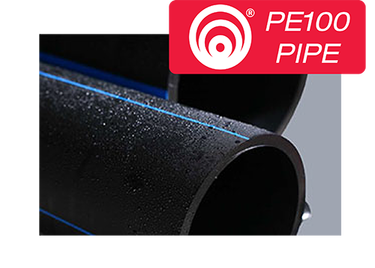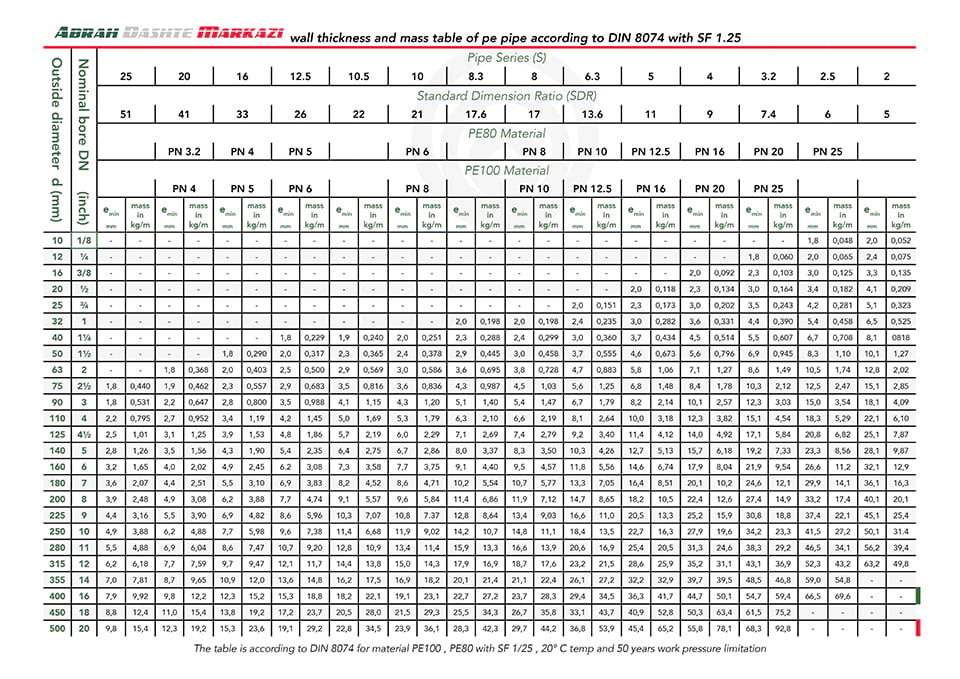 HDPE PIPE
HDPE PIPE
HDPE PIPE Characteristics
HDPE PIPE Due to its flexibility sets apart from other pipe types. Abrah Dashte Markazi Company Manufacturer HDPE PIPE in two base models of PE100 PIPE and PE80 PIPE for cold water and PE-RT Pipe is suitable for use in all hot water pipe applications. HDPE pipe reduces fitting and installation Cost. The polyethylene pipe industry estimates a service life for HDPE pipe to conservatively be 50-100 years. This relates to savings in replacement costs for generations to come to HDPE is the most chemically inert (is not chemically reactive) of all commodity plastics raw materials ( polyethylene, polypropylene, polystyrene, polyvinyl chloride, polymethyl methacrylate, and more ) and HDPE is a chemical and corrosion-resistant HDPE pipe can be heat fused to form a joint that is stronger than the pipe itself and is leak-free. HDPE pipe has mirror smooth inside surface and because of that HDPE pipes have minimum flow head loss Polyethylene is about one-eighth the density of steel, it does not require the use of heavy lifting equipment for installation The combination of flexibility and leak-free joints allow for unique and cost-effective types of installation methods that the rigid PVC and Ductile Iron pipes can't use with bell and spigot connection. These cost-effective types of installation methods are Horizontal Directional Drilling (Long lengths of HDPE pipe are welded together and then installed under roads, creeks, rivers, etc by a Horizontal Directional Drill (HDD)), Pipe Bursting, Sliplining, Plow and Plant, Submerged or Floating Pipe HDPE Due to its non-metallic nature, the material used is totally resistant to all forms of metallic corrosion
HDPE PIPE Chemical and Corrosion Resistant Benefits
- PE is highly resistant to the wet, hydrogen sulfide gas and the low concentration acid found in a sanitary sewer.
- Superior chemical resistance to aggressive soils.
- High-Density Polyethylene (HDPE) pipe will not rust, corrode, tuberculate, or support biological scale or growth, and has superb chemical resistance compared to traditional pipe materials
- High-Density Polyethylene (HDPE) pipe has superb chemical resistance and is the material of choice in harsh chemical environments
- The HDPE PIPE advantages of corrosion and chemical resistance over traditional metal pipes are shared by many plastic pipes, but HDPE pipe uniquely combines these attributes with the aforementioned advantages of heat-fused joints, flexibility, and fatigue resistance.
- High-Density Polyethylene (HDPE) is unaffected by bacteria and fungi, offering resistance to many organic substances.
- To review information on PE's resistance to various chemicals. (TR-19)
HDPE PIPE Heat Fused Joints Benefits
HDPE piping systems can be joined with heat fusion welds Heat fusion involves the heating of two HDPE surfaces then bringing them together to form a permanent, monolithic, leak-free system.
- HDPE pipe can be heat fused in several methods (butt welding or butt fusion, socket fusion, Sidewall fusion, Electrofusion) to form a joint that is as strong or stronger than the pipe itself and is leak-free. Butt fusion and electrofusion are the most common and reliable welding techniques used to weld HDPE and offer significant installation advantages compared to traditional pipe materials. Leak-free and Strong Joints eliminates the potential leak points every 10-20 feet in PVC and Ductile Iron bell and spigot connections.
- The Life Cycle Cost of HDPE pipe differs from other pipe materials because polyethylene is a reliable and cost-effective material that is easy to install and that can be used in most cases the "allowable water leakage" is zero rather than typical leakage rates of 10 to 20% for PVC and Ductile Iron.
- HDPE pipe fused joints are self-restraining and costly thrust restraints or thrust blocks are not required.
- HDPE pipe's fused joints simply do not leak, eliminating infiltration and exfiltration problems experienced with alternate pipe joints.
- the fusion process for HDPE pipe is proven and has been used by the natural gas industry for over 40 years. Approximately 95% of all gas distribution piping in the United States is polyethylene pipe joined by heat fusion
HDPE PIPE Abrasion Resistant Benefits
- PE is abrasion-resistant and is well suited for the solids environment in sewer and Industrial applications.
HDPE PIPE Flexible and Fatigue Resistant Benefits
- HDPE pipe is flexible and ductile, not rigid. It has outstanding resistance to fatigue HDPE pipe can be bent to a radius 25 times the nominal pipe diameter (Example: 12" High-Density Polyethylene (HDPE) can be cold formed in the field to a 25ft radius). This can eliminate many fittings required for directional changes in a piping system where fittings and thrust blocks or restraints are required with alternate materials. Unlike other plastic pipes, it is designed and pressure-rated to handle the kind of occasional and recurring surge events that are common in water distribution systems.
- The flexibility of the HDPE pressure pipe makes it well suited for dynamic soils including areas prone to earthquakes.
- HDPE pressure pipe can accept repetitive pressure surges that significantly exceed the static pressure rating of the pipe. In many instances, this will enable you to utilize a thinner wall HDPE pipe as compared to other types of plastic piping
HDPE PIPE Structure Benefits
- The combination of flexibility and leak-free joints allow for unique and cost-effective types of installation methods that the rigid PVC and Ductile Iron pipes can't use with bell and spigot connections. These alternate installation methods (Horizontal Directional Drilling, Pipe Bursting, Sliplining, Plow and Plant, Submerged or Floating Pipe, etc.) can save considerable time and money in most potable water applications.
- Polyethylene pipe is produced in straight lengths up to 50 feet long and coiled in diameters up through 6". Coiled lengths over 1000ft are available depending on size providing low-cost installations.
- Polyethylene is about one-eighth the density of steel, it does not require the use of heavy lifting equipment for installation.
- HDPE is the material of choice for trenchless methods that provide the most cost-effective solutions (depending on local soil conditions)
HDPE PIPE Cost Effective, Long Term, and Permanent Benefits
- Polyethylene pipe installations are cost-effective and have long term cost advantages Firstly because its failure rate is low, the cost per mile for repair/replacement is also low due to its physical properties, HDPE is fusion-welded joints which ensure very low leakage rates and thus low water loss costs leak-free joints and reduced maintenance costs.
- The polyethylene pipe industry estimates a service life for HDPE pipe to conservatively be 50-100 years. This relates to savings in replacement costs for the next generations to come.
HDPE PIPE Handling Benefits
- It is much easier to handle and install HDPE pipe vs. the heavier, rigid metallic or concrete pipe segments, allowing for significant cost advantages and ROI. Because High-Density Polyethylene (HDPE) is about one-eighth the density of steel, it does not require the use of heavy lifting equipment during installation.
- Polyethylene pipe is better able to structurally withstand an impact than PVC pipe, especially in cold weather installations when other pipes are more prone to cracks and breaks.
- HDPE pipe flexibility allows for bending without the need for additional fittings and can be installed over uneven terrain easily in continuous lengths
HDPE PIPE Hazen Williams C Factor is 150 and doesn't change over time Benefits
- Polyethylene pipe is better able to structurally withstand an impact than PVC pipe, especially in cold weather installations when other pipes are more prone to cracks and breaks.
- It is much easier to handle and install HDPE pipe vs. the heavier, rigid metallic or concrete pipe segments, allowing for huge cost advantages in the construction process.
- HDPE pipe has a smooth ID that does not corrode or tuberculate and maintains its flow capability over time.
- The C Factor of Ductile Iron pipe is dramatically reduced over time due to corrosion and/or tuberculation.
HDPE pipe can be color coated to match installation requirements. typically for pressure installations, HDPE is black with a color-coated stripe. Below you will find a list of common colors and uses:
- Water Distribution - Blue
- Fire Main - Red
- Sewer - Green
- Gas - Yellow
- Reclaimed Water - Purple
HDPE PIPE DATASHEET
![]() HDPE PIPE Catalogue Engineering manual for polyethylene Piping systems
HDPE PIPE Catalogue Engineering manual for polyethylene Piping systems
![]() wall thickness and mass table of pe pipe according to DIN 8074 with SF 1.25
wall thickness and mass table of pe pipe according to DIN 8074 with SF 1.25
![]() Allowable working pressure for pipes conveying water, with a safety factor of 1.25
Allowable working pressure for pipes conveying water, with a safety factor of 1.25
![]() Allowable working pressure for pipes conveying water, with a safety factor of 1.6
Allowable working pressure for pipes conveying water, with a safety factor of 1.6
![]() Allowable working pressure for pipes conveying water, with a safety factor of 2
Allowable working pressure for pipes conveying water, with a safety factor of 2
![]() Allowable working pressure for pipes conveying water, with a safety factor of 1.25
Allowable working pressure for pipes conveying water, with a safety factor of 1.25
![]() Allowable working pressure for pipes conveying water, with a safety factor of 1.6
Allowable working pressure for pipes conveying water, with a safety factor of 1.6
![]() Allowable working pressure for pipes conveying water, with a safety factor of 2
Allowable working pressure for pipes conveying water, with a safety factor of 2
HDPE PIPE Sizes
 |
PE100 PIPE |
 |
PE80 PIPE |
-Pipe.png) |
Polyethylene Raised Temperature (PE-RT) Pipe |
 |
Polyethylene PIPE advantage |







